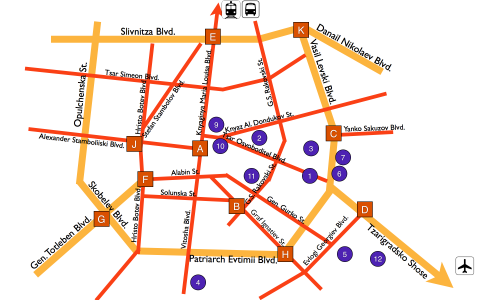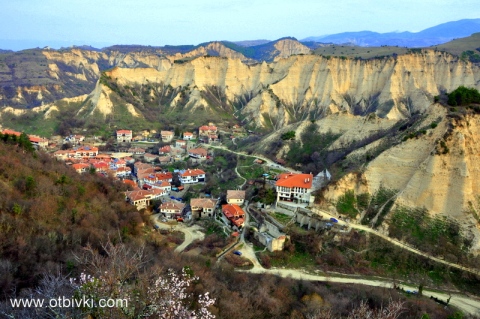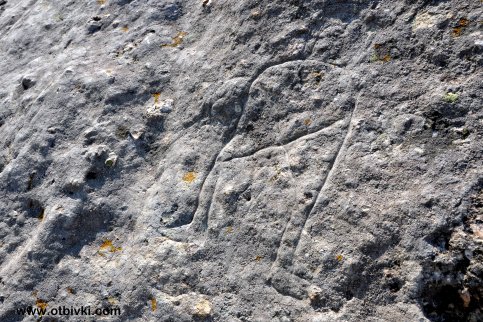“We’re not in Kansas anymore, Toto”
18.06.2013 § 2 Comments
This is a guest post by my friend Kate Latimer, who accepted the invitation of a fellow Bulgarian expat to visit Bulgaria. These are her impressions.
I was sitting over a toilet at 2:30 in the morning, vomiting up the last of my shopska salad I had eaten for dinner, in the early stages of what turned out to be a 48 hour flu that was travelling, if not around the city, then around the apartment I was living in. Three weeks earlier, my Bulgarian best friend had convinced me to get on a plane and travel from Toronto to Sofia so I could see her homeland. It didn’t take much convincing because she had, for the entire time I had known her, lived a double life. She would disappear for months at a time, travelling back to this tiny Eastern European country, and each time she would come home different, somehow transformed by this seemingly sacred experience she would have each Christmas and summer vacation. So when invited, I leapt at this opportunity to go see the place she escaped to, this double life that was moulding my best friend into the person that she is now. Having sat through many history classes in high school, I was confident that not once had Bulgaria been brought up, not once had a history textbook mentioned Bulgaria. My only knowledge of Bulgaria came from sitting around the dinner table with my friend and her parents, as they explained to me the dark and violent history of Bulgaria.
It was this well informed state that led me to ask questions such as, “You guys have electricity, right?” or “There’s gonna be indoor plumbing in the apartment, correct?” My friend rolled her eyes. And so I got on the plane, having no idea what to expect.
The New York Times on Sofia
27.01.2013 § 1 Comment
 Here’s an interesting piece in the NYT on spending 36 hours in Sofia, which I strongly recommend you do if you can’t spend more 😉
Here’s an interesting piece in the NYT on spending 36 hours in Sofia, which I strongly recommend you do if you can’t spend more 😉
“Passport and a Toothbrush” on Sofia
01.10.2012 § Leave a comment
Travel blog Passport and a Toothbrush had some lovely things to say about Sofia when they visited it on their trip through the Balkans.
Read the full post here: Sofia, Bulgaria: Our favourite city in Eastern Europe
My favourite quote from the article:
It oozes effortless cool.
Sofia is like that cool girl in university who doesn’t wear lots of makeup but still manages to look stunning while listening to Them Crooked Vultures on her oversized headphones. Catch my drift? This city may seem like a classic town full of churches and museums but dig around and you’ll find a cool attitude in the streets. Take a stroll on Tsar Ivan Shishman street to get a good feel of funky cafés and even funkier shops.
I’m happy to send these guys some redirects and love, not just because they’re praising the Bulgarian capital, but also because their blog is full of great travel tips and stories from all over the world. In fact, they’ve made my shortlist for the Very Inspiring Blogger Award. I wish Matt and Caro lots of new adventures!
If you’re curious about Sofia, read about my ritual returns, the Essential Walk, Sofia’s street names, its use as a film shooting location, and its book markets.
Gagarin in Plovdiv
08.09.2012 § Leave a comment

On May 23, 1961, 41 days after completing his pioneering spaceflight, first man in space Yuri Gagarin visited Plovdiv on his celebratory tour. He had coffee on the terrace of Hotel Trimontium with various dignitaries and he was made an honorary citizen of Plovdiv. This makes Plovdiv one of only 22 cities to do so, which is claim to fame enough.
However, what was known to very few people until days ago was that he had signed the hotel’s guestbook. « Read the rest of this entry »
Veliko Tarnovo Overview and Travel Guide
31.07.2012 § 2 Comments
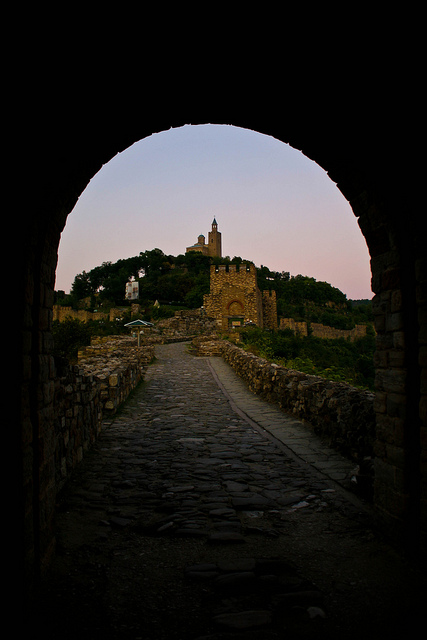
Overview
This is the catch-all post for anyone interested in visiting Veliko Tarnovo. Here I will link to all the individual articles of interest, as well as provide basic practical information about your visit.
In the foothills of the Balkan mountains, around the twists and turns of the Yantra river rise three hills: Tzarevetz, Sveta Gora and Trapezitza. Perched atop these hills and reflected in the river are the houses and castle walls of Veliko Tarnovo – the capital of the Second Bulgarian Empire and once the beating cultural heart of South-Eastern Europe.
« Read the rest of this entry »
Bozhentsi: The End of The Road
29.07.2012 § 1 Comment
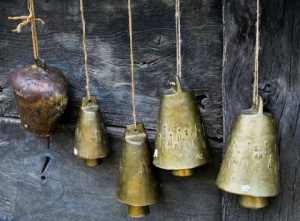 The tiny, barely marked turnoff takes us off the main road to Shipka pass and the drive winds past a few tiny villages, narrowing as it goes, twisting and turning to take us to the village of Bozhentsi. It’s where the road ends. To us, it marks the final point of our short pleasure drive and a chance to stretch our legs in search for dinner on a scorching Saturday afternoon. To the few survivors who fled Veliko Tarnovo after the Ottoman conquest, it meant the beginning of a new life in the safety of the nearby hills. « Read the rest of this entry »
The tiny, barely marked turnoff takes us off the main road to Shipka pass and the drive winds past a few tiny villages, narrowing as it goes, twisting and turning to take us to the village of Bozhentsi. It’s where the road ends. To us, it marks the final point of our short pleasure drive and a chance to stretch our legs in search for dinner on a scorching Saturday afternoon. To the few survivors who fled Veliko Tarnovo after the Ottoman conquest, it meant the beginning of a new life in the safety of the nearby hills. « Read the rest of this entry »
Like an Eastern Block Leader
28.07.2012 § 1 Comment
 The five-star Arbanassi Palace hotel is perched on the crags above Veliko Tarnovo with phenomenal views of the city and the surrounding hills. What makes it unique among luxury hotels in the country is that it was designed and built as a residence for the People’s Republic of Bulgaria long-ruling head of state, Todor Zhivkov. « Read the rest of this entry »
The five-star Arbanassi Palace hotel is perched on the crags above Veliko Tarnovo with phenomenal views of the city and the surrounding hills. What makes it unique among luxury hotels in the country is that it was designed and built as a residence for the People’s Republic of Bulgaria long-ruling head of state, Todor Zhivkov. « Read the rest of this entry »
Walking Tour of Revival-Era Plovdiv
26.07.2012 § 2 Comments

Plovdiv, along with being the site of numerous monuments from its Roman-era past as provincial capital, was also a thriving medieval fortress and an important regional city during the Ottoman rule in Bulgaria and the period of National Revival.
Three of Plovdiv’s six hills are home to an extremely well-preserved Revival-era old town. Housing the city’s art gallery, numerous museums and Revival-era homes preserved and opened to visitors, the Old Town is a must-see during a visit to Plovdiv. Many of the houses on the tour have courtyards walled in by high brick fences, and all feature smaller-area foundations and second and third floors that jut out into the street.
This walking tour will be described as a loop, with one easy entry point from Djumaya mosque square. Keep in mind that, although it’s not clear on the map, this walk involves a few hours of walking up and down hills on cobbled streets. Wear comfortable shoes! Also, unless otherwise stated, museum exhibits are bilingual and available in English. The tour starts in the middle of the main pedestrian street, at Djumaya square.
1. Djumaya Mosque (A)

Djumaya Mosque
The mosque predates the final conquest of Bulgaria, having been built by the Ottomans in the late 1300’s after the fall of Plovdiv. It is built in the older Islamic style, with nine domes resting on four huge internal pillars, which makes it very similar to the mosque in Cordoba. It is an imposing cultural monument and a universal landmark of the city. Any cabbie in Plovdiv can take you to “Djumayata”.
You’ll find the front entrance of the mosque on Saborna street, behind the rolling moat of the Ancient Stadium of Philippopolis.
2. Ascension of the Virgin Mary (“Sveta Bogorodica”) Church (B)

Sveta Bogorodica Church
Instead of taking Saborna, look for the passage behind the mosque, on Krivolak St. Walk past the mosque’s rear along Krivolak for a few blocks and you’ll see a V-shaped intersection. The left side is closed off with a car barrier, and the right is a steep set of stairs leading up to a tall pink tower – the bell tower of the city’s cathedral church – “Ascension of the Virgin Mary”. Built in 1844, it’s a prime example of the Revival period, signalling the start of Bulgaria’s struggle for church independence. It was here that the Plovdiv bishop Paisii read a holy liturgy in Bulgarian, declaring his separation from the Istanbul patriarchate and petitioning the sultan for an independent church. After a few years of struggle, the autocephalous Bulgarian church was re-established in 1870. You’re welcome to enter the church, as it is beautiful inside.
3. The Ancient Theatre (C)
The Roman-era Ancient theatre is on the Old Town hill, and it’s described in detail in my post on Roman architecture in Plovdiv. If you haven’t ventured out to see it on your Roman walk, you should head up the stairs past the church, then down Todor Samodumov street, then turn right on Tzar Ivailo.
4. The Lamartine House (D)
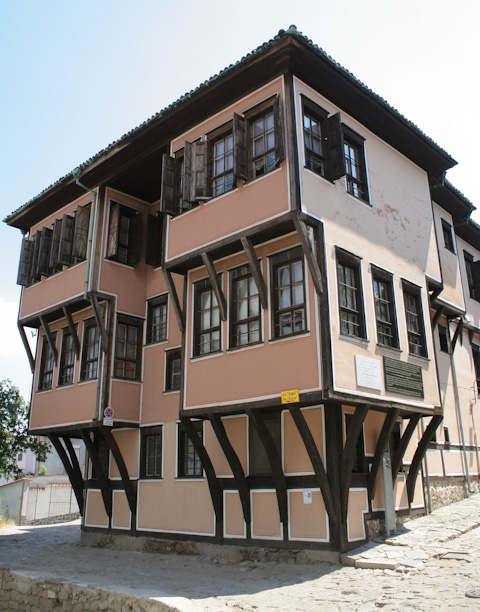
The Lamartine House
Take Tzar Ivailo back and continue right along Todor Samodumov for one more block. You’ll see this yellow house on the corner.
This is the Mavridi house, known as the Lamartine house because French national poet Alphonse de Lamartine stayed there briefly in the summer of 1883. It houses an exhibit devoted to the poet, and is a prime example of symmetric Revival architecture.
5. The City Art Gallery (E)
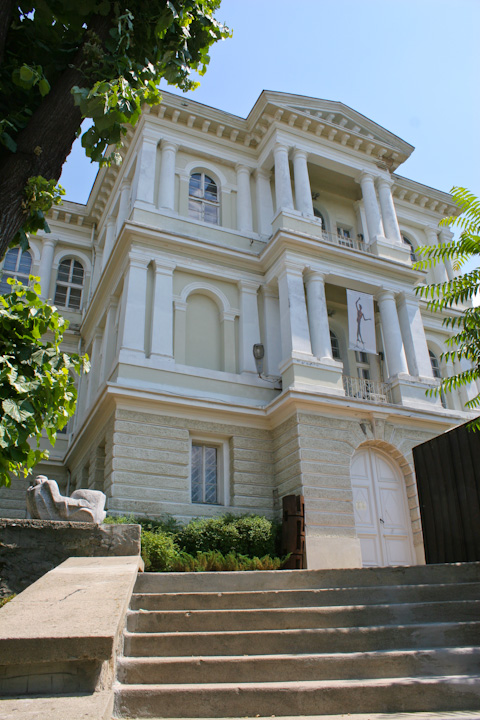
The City Art Gallery
Go back the way you came along Todor Samodumov and turn right at the first opportunity. The street name should be Stoyan Chalakov. Walking down, on your right you’ll see a set of stairs and a socialist realism mural leading up to a pale brown house.
This is the main building of the City Art Gallery. On two compact floors, it has a great collection of Bulgarian art from the late 1800’s to present day, including paintings of Vasil Levski, self-portraits of many renowned painters who worked in Bulgaria, and a scale model of the monument to Tzar Liberator in Sofia. Entrance to the gallery costs 2 Leva (1 for students), and a guided visit is 10 Leva in English.
5.5. The Gallery’s Icon Collection (F)
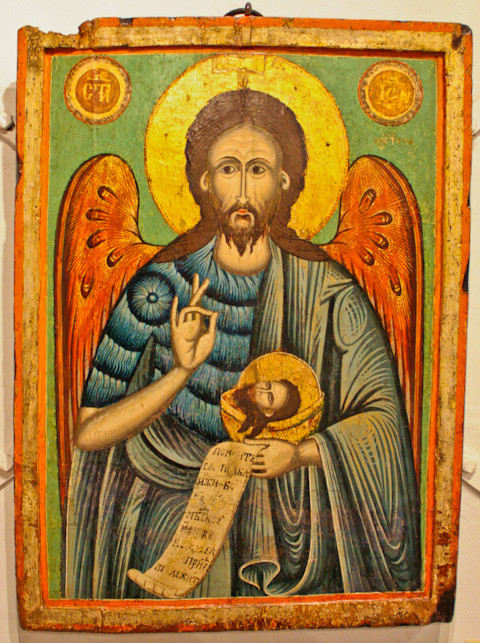
An icon from the Icon Collection
Half a block down the street, on Saborna St. 22, you can find a branch of the City Gallery devoted to iconography: the Eastern Orthodox art of painting images of saints and religious scenes. Entrance to the gallery costs 2 Leva (1 for students), and a guided visit is 10 Leva in English.
6. Sv. Konstantin & Elena Church (G)

The bell tower of St. Konstantin & Elena church
Just behind the Icon Collection, you will see a church’s bell tower jutting out above a walled-in garden. Go inside and you’ll see the facade of the beautiful Sv. Konstantin & Elena church. Entrance is free, as it is in all churches in the country, but picture-taking is not allowed inside.
7. Hisar Kapia and the Round Tower (H)

The Hisar Kapia gate
After the church, take a right and you’ll see the arch of one of the gates of the ancient fortress of Hisar Kapia, built in the 5th century AD. If you turn right again along the ancient wall that the gate hints at, you’ll reach the foundations of a round Byzantine-style tower. These are small remnants of Plovdiv’s Byzantine-era past.
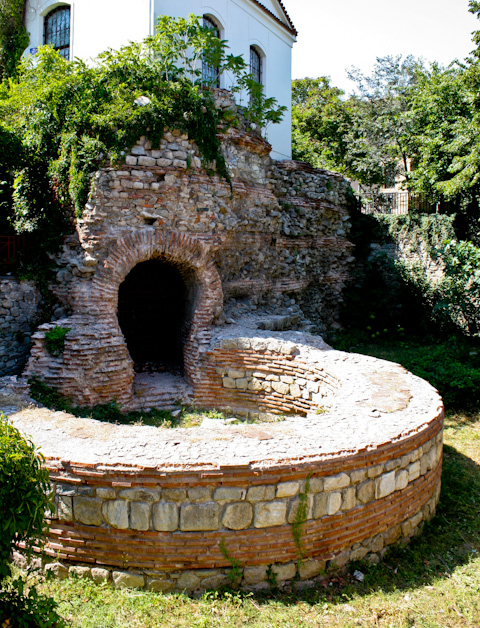
The round tower
8. Museum for National Revival (I)
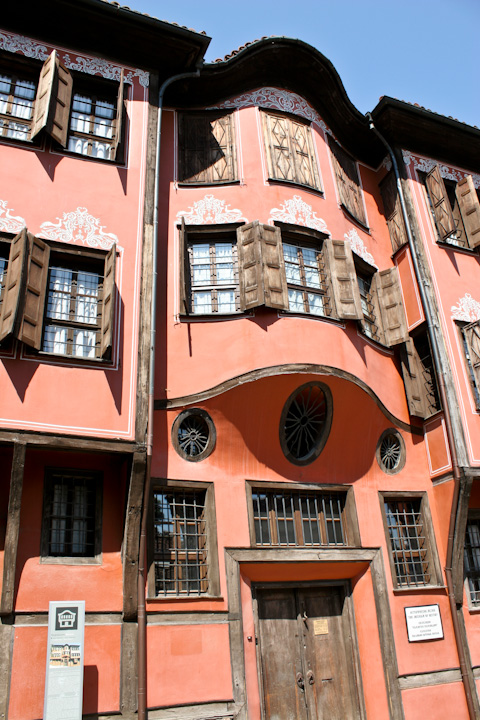
Museum for National Revival
Coming back from the Round Tower, with the Hisar Kapia gate on your left, you’ll see a big orange house ahead of you. This is the National Revival museum that houses exhibits on city life in the final years of Ottoman dominion, as well as weapons and stories from the April uprising of 1876, the Russo-Turkish war of 1877-78, and Plovdiv’s liberation. Be warned, not all the museum’s exhibits are bilingual, although there are explanatory sheets in English posted at the entrance to each exhibit room. Entrance is 2 Leva (1 Lev for students) and a guided tour of the museum costs 6 Leva. Picture-taking will set you back another 1 Lev.
9. Ethnographic Museum (J)

The Ethnographic Museum
Walk back through the Hisar Kapia gate and turn right down Dr.Chomakov street, keeping your eyes open to the right.
Walled behind a high brick fence, the most beautiful house in the Old Town also houses the city’s Ethnographic museum, i.e. the place to see what life looked like in Revival-era Plovdiv, both in the nearby villages and in the city itself. The exhibits, co-sponsored by National Geographic Bulgaria, are well arranged and decidedly worth seeing. Entrance to the museum is 5 Leva (1 Lev for students) and a guided tour in English will cost you 10 Leva.
NOTE: The Ethnographic museum is CLOSED Mondays.
10. Nebet Tepe (K)
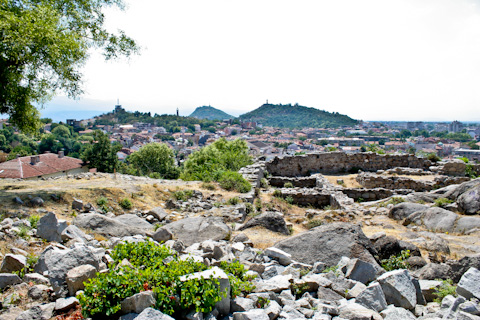
View of Plovdiv from Nebet Tepe’s fortress
Nebet Tepe (the “Nebet Hill”), one of the Old Town’s three hills, at the end of Dr. Chomakov Street, is peppered with the ruins of an ancient Thracian fortress. While not a savoury place to visit after dark, it offers incredible views of Plovdiv. Additionally, just before the path up to the fortress, on the left you will find the Bakalov house, where traditional artisans offer demonstrations of their crafts and sell their wares.
11. Balabanov and Hindliyan Houses (L)

The Hindliyan House
Go back down Dr. Chomakov street until the square before St. Konstantin & Elena. The street leading right will be called Antranik, and on the corner you’ll see the pink Balabanov House. Walk around it until you see the small gate in the wall. You can enter through there. The Balabanov house, as well as the adjacent Hindliyan house in blue (that you can reach from the Balabanov courtyard), are both perfectly restored Revival homes, housing an art gallery and a recreation of the Baroque-era sitting rooms of wealthy Bulgarian merchants in one, and a basement Turkish bath in the other. Entrance to each of the houses is 5 Leva (1 for students), and a guided tour costs 15 Leva.
12. Art Gallery Philippopolis (M)
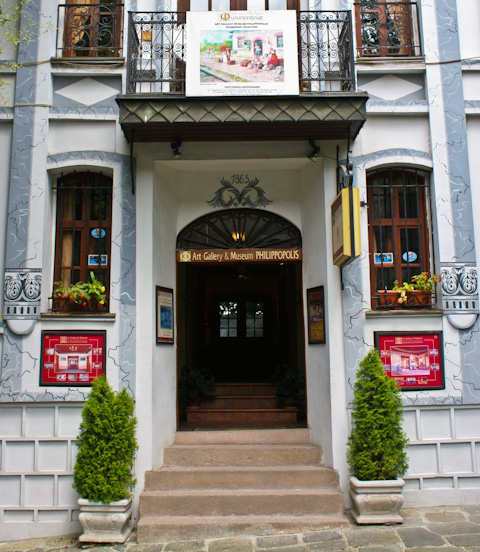
Art Gallery Philippopolis
When you’ve finished with the two houses, head back to the square and turn right, taking Saborna back towards the entrance to the Old Town. At the intersection with Vasil Kanchev and Stoyan Chalakov, Saborna veers slightly to the right. You should follow it, and at number 29, you’ll find the house of Hadji Aleko, currently private art gallery Philippopolis. It’s another beautiful Revival-era house (built around 1865).
Your tour ends at the end of Saborna, at the barrier near the stairs. Walking onwards will return you to Djumaya square, past the area known as Kapana, full of artisan shops.
Plovdiv’s Roman Treasures: A Walking Tour
25.07.2012 § 8 Comments

In 1968, the sports field of the Pedagogy Institute in Bulgaria’s second-largest city, sun-drenched Plovdiv, was scheduled for refurbishment. A company of the Army’s construction corps was assigned to expand the field, which involved digging deeper into one of the city’s three hills. However, the Institute never got its field, because what the diggers found underneath were the curved marble seating rows of an immaculately preserved outdoor Roman theatre.
Plovdiv, inhabited continuously since 4000 BC and Europe’s third-oldest city (after Athens and Argos), is known by many names. Settled by the Thracians as Eumolpias, it was conquered by Philip II of Macedon, the father of Alexander the Great, and given the name Philippopolis. After the decline of the Macedonian kingdom, it reverted to the Thracians, who called it Pulpudeva. When the Romans swept onto the Balkans, they called it Trimontium (“City of Three Hills”) and made it a cultural and economic hub of the Roman province of Thrace. The via militaris, one of the Roman empire’s arterial roads, passed through the city, and it thrived on the banks of the Hebros (Maritsa) river, at one time containing numerous public buildings, baths, shrines, villas, with high walls and a Roman grid system in its streets. This walking tour will take you on a trip through its main Roman-era sights.
« Read the rest of this entry »
The Comfort of Familiarity…and Big Macs (Updated)
24.07.2012 § 5 Comments
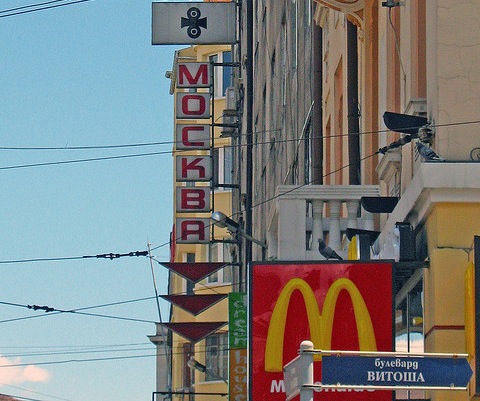
In August of 2010, I had just arrived in Sofia for a month-long stay in Bulgaria. I’d rushed out to buy кисело мляко, сирене and лютеница, to have a taste of authentic Bulgarian things, and I was excited to participate in a ritual I like to call The Walk.
The Walk essentially consists of my taking the trolley down to Sofia University and strolling through all the places in the centre of the city that I want to refresh in my memory. It is a slow, leisurely affair, notably because usually it’s undertaken in the scorching summer heat, and it serves to suffuse me with the understanding that I am, indeed, home. You will see many of these landmarks in future posts if you haven’t already, but they include the yellow cobbles, the National Theatre (where I spend a good half an hour admiring it and wondering what might have been if I’d been a superfamous actor slash director slash sex symbol person…but I digress) and a dozen other known and unknown places that really ground me, telling me “Yes, you are in Sofia”.
Entering a Bulgarian Orthodox Church
24.07.2012 § 2 Comments
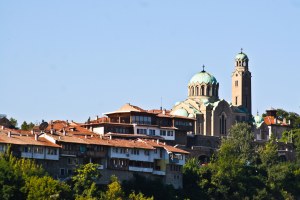
When travelling in Bulgaria, you’ll be hard-pressed to find a city or town without a church as a significant landmark. The Orthodox church was a haven for Bulgarian language and culture during the almost 500 years of Ottoman dominion and its buildings tend to be the source of much local pride. Many churches feature prominently on walking tours and tourist information sites and you’ll likely find yourself entering church after church during your stay. « Read the rest of this entry »
Off to Bulgaria!
09.07.2012 § 3 Comments
Hello, my throngs of loyal followers!
The time has come: I leave Toronto tomorrow, via Munich, Venice, Verona, Florence and Rome, for Bulgaria.
I will spend close to four weeks there, writing helpful guides and impressions on location from Sofia, Plovdiv, Veliko Tarnovo and Ruse. I will also be undertaking a 7-day hike through the Eastern Rhodopes, which will be detailed like my routes through the Balkans and Rila.
If you have requests, about anything at all (language, customs, shopping etiquette, travel guides), now is the time to send them to me as I will be able to research them at the source.
So, please comment on this post with your requests, and I will do my utmost to fulfill them.
My next post will be from sunny Sofia!
Bulgaria on National Geographic’s “Best Tours of Europe” List for 2012
25.06.2012 § Leave a comment
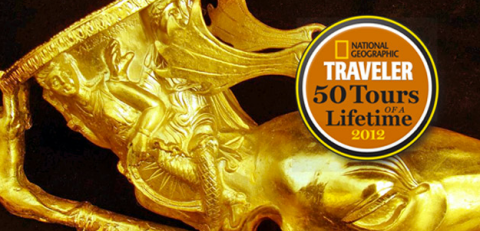 A 12-day comprehensive tour of Bulgaria is one of the ten prime European tours for 2012 according to National Geographic‘s “50 Tours of a Lifetime” list.
A 12-day comprehensive tour of Bulgaria is one of the ten prime European tours for 2012 according to National Geographic‘s “50 Tours of a Lifetime” list.
The tour features a spectacular itinerary and is a good bargain at ~5000$ (minus airfare). Food, wine tastings, 4- and 5-star hotels, and visits to Bulgaria’s foremost sights are included.
The Legacy of Nikola Fichev
20.06.2012 § 3 Comments
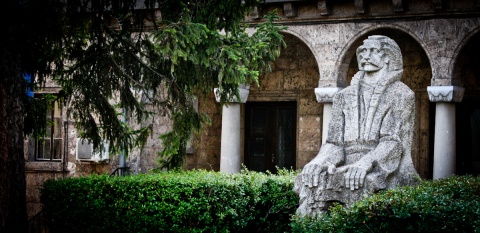
Nikola Fichev (also known as Kolyu Ficheto) is Bulgaria’s best-known Revival-era master-builder and architect. An orphan, he became a builder’s apprentice at age 10, and eventually taught himself the fundamentals of construction, architecture, drafting and arithmetic required to become one of the most prolific masters of the 19th century. He was also fluent in Turkish, Greek, Serbian and Romanian.
In his lifetime (1800-1881), he built four bridges, over a dozen churches, a town hall, monasteries, houses and inns, all between Veliko Tarnovo and the Danube port of Svishtov. He used innovative building methods and embedded revolving pillars into several of his churches. The pillars would be able to freely rotate around their centres as long as the integrity of the building’s foundations was not compromised. Despite being built almost 150 years ago, many still revolve to this day. Here are just a few of his masterpieces that can still be seen in Bulgaria.
Sofia’s Street Names and Major Landmarks
16.06.2012 § 2 Comments
What’s in a name? This post will give you a general idea of the layers of history and city planning in Bulgaria’s capital, based on the names of its major streets and arteries. Furthermore, it will acquaint you with several landmarks and important city squares.
Melnik: The City of the Sand Guards
13.06.2012 § 1 Comment
Translated with permission from otbivki.com, a Bulgarian-language travel and adventure blog. Melnik is a city approximately 200 km to the south of Sofia, near Sandanski, on the southwestern tip of Bulgaria.
The road is winding before us like a snake in the sun. The white strip of asphalt zooms past expansive vineyards and quiet houses, racing against time towards its final goal. It leads us ever South, leaving the villages of Lozenitza and Harsovo somewhere behind us. We’re approaching Melnik…
The pyramids are the first to greet us. We call them the “sand guards” because they resemble a line of soldiers guarding the city. In their embrace lie nestled the white houses of Melnik – the smallest Bulgarian settlement with city status. It turns out to be warm, unpretentious and somehow full of humble, harmonious beauty.
Vampires: The Bulgarian Connection
08.06.2012 § 7 Comments

According to the BBC, Sofia News Agency, and a few dozen other outlets, the “remains of two vampires” were discovered in a tomb near the Bulgarian seaside town of Sozopol. In other words, two skeletons were unearthed posthumously pinned to their graves with iron spikes through the chest.
Bozhidar Dimitrov, a Sozopol native and Bulgaria’s chief historian, explains that there have been over 100 such burials found on Bulgarian territory, mostly dating back to the Middle Ages. He goes on to explain some of the historical background and symbolism behind the ritual.
Perperikon: The City of Stone
07.06.2012 § Leave a comment
Translated with permission from otbivki.com, a Bulgarian-language travel and adventure blog.
In the hot summer day, dust is our most faithful companion. It sticks to our shoes, our face and our clothes as we walk along the narrow path in a single file. I hear our footsteps leave quiet prints and race with the stones – how many generations have taken this path, how many tribes and civilizations have ascended the steep slope, to experience victories, losses, opulence, poverty or death? For centuries, the cliffs have kept their history, ready to share it with every visitor of the City of Stone.
It appears before us, clad in the golden garb of sunshine, regal, serene and unwavering. Its name is Perperikon.
A Tour of Sofia in “Hitman” Movie Frames
03.06.2012 § 1 Comment
 The not-terribly-brilliant 2007 movie treatment of the video game series Hitman starring Timothy Olyphant and directed by Xavier Gens is notable for being shot primarily in Sofia. The Bulgarian capital is standing in for Moscow, but, as a pedantic and shrewd movie-goer, I have extracted a few screenshots that are definitive Sofia landmarks.
The not-terribly-brilliant 2007 movie treatment of the video game series Hitman starring Timothy Olyphant and directed by Xavier Gens is notable for being shot primarily in Sofia. The Bulgarian capital is standing in for Moscow, but, as a pedantic and shrewd movie-goer, I have extracted a few screenshots that are definitive Sofia landmarks.
Seven Rila Lakes (Hiking Route)
25.05.2012 § 2 Comments
 The seven Rila lakes are a group of glacial lakes in northwestern Rila. At an altitude ranging from 2100 to 2500 m above sea level, they are the most visited mountain lakes in Bulgaria, and with good reason. Layered one above the other, they are wild, picturesque and clear, and the paths between them are rocky and steep. Buses from Sofia stop at the nearby town of Sapareva Banya, which is a day’s walk from the lakes. Two mountain lodges operate nearby: the old one (“Rila lakes” mountain lodge) and the new one (“Seven lakes” lodge). All lakes are located above the tree line, meaning that the vegetation around them consists mostly of grass and shrubs.
The seven Rila lakes are a group of glacial lakes in northwestern Rila. At an altitude ranging from 2100 to 2500 m above sea level, they are the most visited mountain lakes in Bulgaria, and with good reason. Layered one above the other, they are wild, picturesque and clear, and the paths between them are rocky and steep. Buses from Sofia stop at the nearby town of Sapareva Banya, which is a day’s walk from the lakes. Two mountain lodges operate nearby: the old one (“Rila lakes” mountain lodge) and the new one (“Seven lakes” lodge). All lakes are located above the tree line, meaning that the vegetation around them consists mostly of grass and shrubs.
Botev Peak (Hiking Routes)
17.05.2012 § 2 Comments
 Standing at 2376 m above sea level, Botev is the tallest peak in Stara Planina. It lies within the boundaries of national park “Central Balkan” – a beautiful natural reserve protecting 72 000 hectares of natural beauty. Botev peak is a popular hiking destination and can be reached via one of several routes, most of which are suitable for beginners. This part of Stara Planina is very picturesque: rocks and imposing cliff faces give way to cool forests, grassy pastures transition into shrubs and every peak offers a unique and marvellous vantage point.
Standing at 2376 m above sea level, Botev is the tallest peak in Stara Planina. It lies within the boundaries of national park “Central Balkan” – a beautiful natural reserve protecting 72 000 hectares of natural beauty. Botev peak is a popular hiking destination and can be reached via one of several routes, most of which are suitable for beginners. This part of Stara Planina is very picturesque: rocks and imposing cliff faces give way to cool forests, grassy pastures transition into shrubs and every peak offers a unique and marvellous vantage point.
